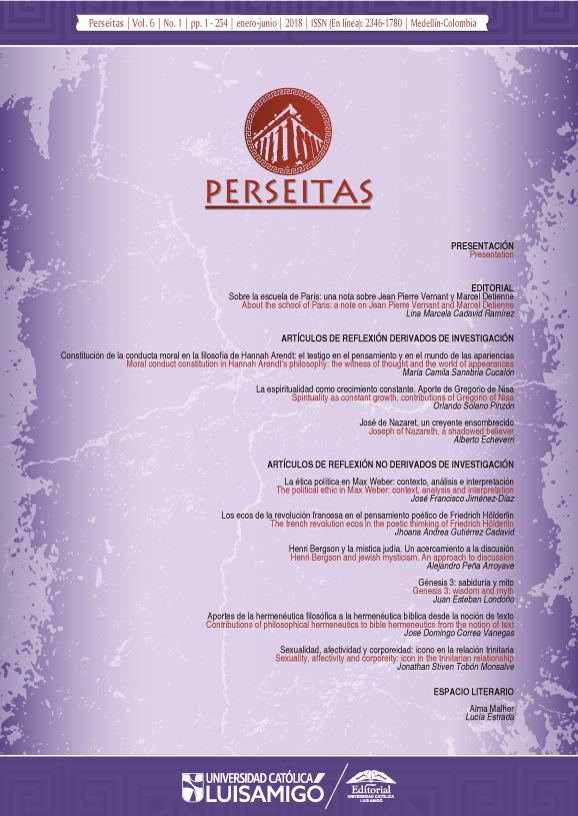Henri Bergson and jewish mysticism. An approach to discussion
DOI:
https://doi.org/10.21501/23461780.2686Keywords:
Christianity, Dynamism, Language, Mysticism, Judaism.Abstract
The writing states the relationship between mysticism according to Bergson
and its relationship with Jewish mysticism. Although Bergson himself affirms
that the most finished mysticism is presented in Christianity, a revision to the
basis of optimism about the creation in which dynamic religion is founded, as an
expression of finished mysticism, let us to understand how mysticism finished
that Bergson states it is closer to the Jewish sources than to its Christian
consummation. For this, the writing is developed in three moments: the first
one makes a presentation of the main elements of mysticism in Bergson. The
second takes into account the considerations of Martin Buber and Hermann
Cohen about the tension between law and love in Jewish mysticism. And, in the
third moment, under the light of the notion of dynamic creation, as a foundation
of the mysticism finished according to Bergson and as a fundamental concept
of Judaism, they are proposed some common points between Bergson and
Judaism in three central aspects: the relationship of the Mystical experience
with language, tradition and the foundation of a moral.
Downloads
References
Bergson, H. (1946). Las dos fuentes de la moral y de la religión. Buenos Aires: Sudamericana.
Bergson, H. (1959). “Pensamiento y movimiento”. En Obras escogidas. México: Aguilar.
Buber, M. (1955). En la encrucijada. Tres conferencias sobre el judaísmo. Buenos Aires: Sociedad Hebraica Argentina.
Buber, M. (1983). Cuentos jasídicos. Los primeros maestros I. Madrid: Paidós.
Buber, M. (1993). Eclipse de Dios. México: Fondo de Cultura Económica.
Buber, M. (2006). Imágenes del bien y del mal. Buenos Aires, Argentina: Lilmod.
Chacón, P. (1994). “Mecánica y mística: la filosofía de la religión de Henri Bergson”. En Filosofía de la religión: estudios y textos (pp. 403-425).Madrid: Trotta.
Chevalier, J. (1960). Conversaciones con Bergson. Madrid: Aguilar.
Cohen, H. (2010). Mesianismo y razón. Escritos judíos. Buenos Aires: Lilmod.
Fackenheim, E. (2005). ¿Qué es el judaísmo? Una interpretación para nuestra época. Buenos Aires: Lilmod.
Gilson, E. (1962). El filósofo y la teología. Madrid: Guadarrama.
Hartman, D. (2006). El pacto viviente. El espíritu de innovación en el judaísmo tradicional. Buenos Aires: Lilmod. Instituto Shalom Hartman.
Hegel. G. W. F. (1984). El espíritu del cristianismo y su destino. Buenos Aires: Rescate.
Heidegger, M. (1999). Estudios sobre mística medieval. México: Fondo de Cultura Económica.
Husserl, E. (2002). Renovación del hombre y de la cultura. Cinco ensayos. Barcelona: Anthropos.
James, W. (1986). Las variedades de la experiencia religiosa. Tomo II. Buenos Aires: Hyspamérica.
Jankélévitch, V. (1962). Henri Bergson. Xalapa: Universidad Veracruzana.
Manzano, J. (2007). “La mística según Bergson” en Xipe-Totek, 16(1), 5-18.
Martín Velasco, J. M. (2003). El fenómeno místico. Madrid: Trotta.
Plotino. (1985). Enéadas III-IV. Madrid: Gredos.
Rosenzweig, F. (2007). Lo humano, lo divino y lo mundano. Escritos. Buenos Aires: Lilmod.
Scheler, M. (1960). Metafísica de la libertad. Buenos Aires: Nova.
Schelling, F. W. J. (1858). Philosophie der Offenbarung. Stuttgart. Augsburg: Cotta.
Scholem, G. (2006). Grandes tendencias de la mística judía. Madrid: Siruela.
Scholem, G. (2008). Conceptos básicos del judaísmo. Madrid: Trotta.
Scholem, G. (2015). La Cábala y su simbolismo. México: Siglo XXI.
Zubiri, X. (1992). Cinco lecciones de filosofía. Madrid: Alianza Editorial.
Downloads
Published
How to Cite
Issue
Section
License
Copyright (c) 2018 Perseitas

This work is licensed under a Creative Commons Attribution-NonCommercial-NoDerivatives 4.0 International License.
La revista y los textos individuales que en esta se divulgan están protegidos por las leyes de copyright y por los términos y condiciones de la Licencia Creative Commons Atribución-No Comercial-Sin Derivar 4.0 Internacional.
















